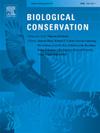Movement ecology and conservation of capuchin monkeys in pine plantation landscapes
IF 4.4
1区 环境科学与生态学
Q1 BIODIVERSITY CONSERVATION
引用次数: 0
Abstract
Pine plantations significantly alter wildlife spatial ecology, yet some arboreal mammals, particularly primates, persist in these landscapes. Some primates may bark-strip pines, generating conflicts with producers, further threatening their populations. Black capuchin monkeys (Sapajus nigritus), endemic to the Atlantic Forest, inhabit both native forests and plantation-dominated landscapes. Here we studied the effect of pine plantations on movement and space use pattern of capuchins. Using data from 2008 to 2024, we applied Hidden Markov Models and Auto-correlated Kernel Density Estimators to study movements and space use of 11 capuchin groups in northeastern Argentina, comparing pine plantations and protected forests. Capuchins in plantations traveled longer daily distances. In plantations, stationary movement state, linked to resting and feeding, were more frequent in forest fragments, while rapid directional movements prevailed in pine stands. Stationary movements increased in pine stands during peak bark-stripping periods. Home ranges in plantations nearly tripled those in protected forests. Core areas in plantation landscapes were highly concentrated in native forest fragments. Despite fragments constituting only 22 % of the plantation landscape, they concentrated 95 % of sleeping sites, shaping capuchins' daily movements. Resource scarcity and fragmentation increase capuchins' daily trajectories, home ranges, and core areas, likely reducing carrying capacity. Preserving forest fragments and ensuring their connectivity is essential to maintaining habitat quality for primates in plantation landscapes. Movement ecology insights from capuchins in pine plantations are key for conservation planning with the aim of developing primate-friendly production landscapes, and mitigating conflicts between primates and foresters.

松林景观中卷尾猴的运动生态学与保护
松树人工林显著地改变了野生动物的空间生态,然而一些树栖哺乳动物,特别是灵长类动物,在这些景观中持续存在。一些灵长类动物可能会剥去松树的树皮,与生产者产生冲突,进一步威胁到它们的种群数量。黑卷尾猴(Sapajus nigritus)是大西洋森林的特有种,栖息在原生森林和人工林主导的景观中。本文研究了松林对卷尾猴活动和空间利用模式的影响。利用2008年至2024年的数据,应用隐马尔可夫模型和自相关核密度估计器对阿根廷东北部11个卷尾猴种群的活动和空间利用进行了研究,并对松树人工林和保护区进行了比较。种植园里的卷尾猴每天要走更长的距离。在人工林中,与休息和取食有关的静止运动状态在森林碎片中更为常见,而在松林中则以快速定向运动为主。在剥皮高峰期,松林的静止运动增加。人工林的栖息地面积几乎是保护区的三倍。人工林景观的核心区高度集中在原生林碎片中。尽管碎片只占种植园景观的22%,但它们集中了95%的睡眠地点,塑造了卷尾猴的日常活动。资源稀缺和碎片化增加了卷尾猴的日常轨迹、家园范围和核心区域,可能降低了承载能力。保护森林碎片并确保它们的连通性对于维持灵长类动物在人工林景观中的栖息地质量至关重要。松林卷尾猴的运动生态学洞察是保护规划的关键,其目的是发展对灵长类动物友好的生产景观,并缓解灵长类动物与林业人员之间的冲突。
本文章由计算机程序翻译,如有差异,请以英文原文为准。
求助全文
约1分钟内获得全文
求助全文
来源期刊

Biological Conservation
环境科学-环境科学
CiteScore
10.20
自引率
3.40%
发文量
295
审稿时长
61 days
期刊介绍:
Biological Conservation is an international leading journal in the discipline of conservation biology. The journal publishes articles spanning a diverse range of fields that contribute to the biological, sociological, and economic dimensions of conservation and natural resource management. The primary aim of Biological Conservation is the publication of high-quality papers that advance the science and practice of conservation, or which demonstrate the application of conservation principles for natural resource management and policy. Therefore it will be of interest to a broad international readership.
 求助内容:
求助内容: 应助结果提醒方式:
应助结果提醒方式:


